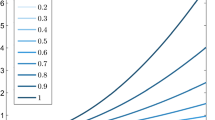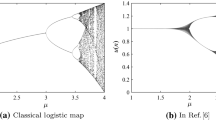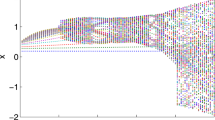Abstract
Recently the discrete fractional calculus (DFC) started to gain much importance due to its applications to the mathematical modeling of real world phenomena with memory effect. In this paper, the delayed logistic equation is discretized by utilizing the DFC approach and the related discrete chaos is reported. The Lyapunov exponent together with the discrete attractors and the bifurcation diagrams are given.
Similar content being viewed by others
Explore related subjects
Discover the latest articles, news and stories from top researchers in related subjects.Avoid common mistakes on your manuscript.
1 Introduction
The discrete dynamic behavior and its applications have been paid much attention in various applied areas, such as synchronization control [1–3], secure communication [4, 5], biomolecular network evolution [6, 7], and so on.
The DFC is one of recent topics and some results were already reported in the discrete fractional dynamics. In 1989, Miller and Ross [8] began the theory of the fractional difference, and the fractional integral was given as a fractional summation. After that, several authors developed the theory of the fractional difference equations on time scales [9], such as the initial value problems [10], the discrete calculus of variations [11], the Laplace transform [12, 13], the properties of the Caputo and the Riemann-Liouville difference [14], and so on (see, for example, Refs. [15–21] and the references therein). Very recently, the DFC tool was applied to the chaotic aspects of the discrete systems in [22, 23]. The logistic map of fractional order is proposed as
It holds discrete memory effects and can describe the long interaction of the systems. Besides, the parameter \(\nu \) can be varied and the more general chaos can shrink to the results of integer maps for the \(\nu =1\). These merits help us understand the discrete chaotic behaviors more deeply.
This study considers the general results in a two-dimensional case and it is organized as follows: Sect. 2 introduces some of the basic definitions and the preliminaries of the DFC. In Sect. 3 we applied the tool of the DFC to the two-dimensional logistic equation and a discrete fractional map is obtained. Then the chaotic behaviors are reported and the bifurcation diagrams are given for various difference orders.
2 Basic definitions and preliminaries
In the following we recall some definitions and preliminaries of the DFC. The following notation \(\mathbb {N}_a\) denotes the isolated time scale and \(\mathbb {N}_a=\{a,a+1,a+2,\ldots \}, \) (\(a \in \mathbb {R}\) fixed). For the function \(x(n)\), the difference operator \(\Delta \) is defined as \(\Delta x(n)=x(n+1)-x(n)\).
Definition 2.1
([10]) Let \(x:\) \(\mathbb {N}_a\rightarrow \mathbb {R}\) and \(0<\nu \) be given. Then the fractional sum of order \(\nu \) is defined by
where \(a\) is the starting point, \(\sigma (s)=s+1\), and \(t^{(\nu )}\)is the falling function defined as
Definition 2.2
([14]) For \(0<\nu < 1\), and \(x(t)\) defined on \(\mathbb {N}_{a}\), the Caputo-like delta difference is defined by
Theorem 2.3
The delta fractional difference equation
has an equivalent discrete integral equation
Proof
Suppose that \(x(t)\) is a solution of (5), then according to the discrete Taylor expansion [16]
and substituting Eq. (5) into Eq. (7), we can prove (6).
Conversely, if \(x(t)\) is a solution of (6), from the right hand sides of (6) and (7), we can obtain
As a result, we get that
which implies that \(x(t)\) is a solution of (6). \(\square \)
3 Discrete chaos in fractional delayed logistic maps
3.1 Fractional discretization of the delayed logistic equation
The logistic equation
is originally proposed by Verhulst [24] in 1845 and has numerous applications. Particularly in the biology and ecology, the model depicts the ratio of the population’s growth.
As it was already pointed out by Hutchinson [25], the events from nature are not continuous, therefore, we have seasonal cycle which generates oscillations due to the internal demographic factors. In view of this point, the discrete maps can better depict the evolution of the population.
Several modified logistic equations and their discrete versions have been suggested in [25–33]. One of them is the delayed logistic map [29], namely
It is derived by the discretization of the delayed Eq. [25]
where \(\tau \) is the delay time and \(\mu \) denotes the rate of the maximum population growth. We assume that the amount of resources available at time \(t\) will depend on the density of the species at an earlier time by a delay of \(\tau \).
At this point we recall that some discretization techniques were reported in the literature [10–14, 34–38]. We introduce the following fractional difference equation by the DFC [10–14]
By using the Theorem 2.3 we obtain the fractional delayed logistic maps as
The initial iterations are assumed as \(x(0)=y(0)=0.001\).
We notice that for \(\nu =1\), the system reduces to the following delayed logistic map
and \(x(0)=x(-1)=0.001\).
Since there is a discrete weighted or kernel function \(\frac{\varGamma (n-j+\nu )}{\varGamma (n-j+1)}\) in (13), the present statue \(x(n)\) depends on the past information \(x(0),\ldots ,x(n-1)\) which is called the discrete memory effect. This is one of crucial differences between the fractional map and the classical one.
3.2 Discrete chaos in fractional delayed logistic maps
We recall that the system (14) generates a chaotic series for \(\mu =1.25\) and comes across the Hopf bifurcation. With the mathematic software Maple, we plot the numerical solution and the discrete attractor in Fig. 1a, b, respectively. Figure 2 represents the bifurcation diagram.
Now we consider the fractional case for \(\nu =0.8\). Figures 3, 4 and 5 illustrate the dynamic behaviors of the system when the coefficient \(\mu \) is varied. Figure 6 is the bifurcation diagram. It is found that quasiperiodic behavior persists over most of the range of \(1.096<\mu <1.412\) and some for \(1.412<\mu \). In order to distinguish the chaos, we discard the first 70 values of \(x(i)\) and adopt the Jacobian matrix algorithm to plot the distribution of the maximal Lyapunov exponents in Fig. 7. Through the analysis of the positive Lyapunov exponents, we can note that the system meets chaotic statues when \(\mu \) increases through 1.096. We enlarge the interval [1.3, 1.412] in Fig. 8. It can be more clearly observed that the chaotic zone is non-continuous from Figs. 7 and 8.
A piece of the bifurcation diagram (6) and its enlargement
Similarly, for \(\nu =0.6\) and \(\nu =0.4\), we can give the bifurcation diagrams in Figs. 9 and 10, respectively. For the varied difference order, the chaotic zones are different and new chaotic behaviors are observed.
4 Conclusions
This study applies the DFC to the two-dimensional delayed logistic equation and as a result a novel delayed logistic map of fractional difference order is given in a form of an iteration formula. Then the dynamic behaviors are discussed by varying the coefficient \(\mu \) and the difference order \(\nu \). The Lyapunov exponents are plotted to identify the chaos. The reported results show that the discrete fractional maps hold some new degrees of freedom which can be used in catching the hidden aspects for real world phenomena encountered in ecology.
References
Wang, X.F., Chen, G.: On feedback anticontrol of discrete chaos. Int. J. Bifurc. Chaos 9, 1435–1441 (1999)
Yang, X.S., Chen, G.: Some observer-based criteria for discrete-time generalized chaos synchronization. Chaos Solitons Fractals 13, 1303–1308 (2002)
Yan, Z.: QS synchronization in 3D Henon-like map and generalized H\(\acute{e}\)non map via a scalar controller. Phys. Lett. A 342, 309–317 (2005)
Pareek, N.K., Patidar, V., Sud, K.K.: Image encryption using chaotic logistic map. Image Vis. Comput. 24, 926–934 (2006)
Behnia, S., Akhshani, A., Mahmodi, H., Akhavan, A.: A novel algorithm for image encryption based on mixture of chaotic maps. Chaos Solitons Fractals 35, 408–419 (2008)
Jalan, S., Amritkar, R.: Self-organized and driven phase synchronization in coupled maps. Phys. Rev. Lett. 90, 014101 (2003)
Atay, F.M., Jost, J., Wende, A.: Delays, connection topology, and synchronization of coupled chaotic maps. Phys. Rev. Lett. 92, 144101 (2004)
Miller, K.S., Ross, B.: Fractional difference calculus. In: Proceedings of the International Symposium on Univalent Functions, Fractional Calculus and Their Applications, Nihon University, Koriyama, Japan, May 1988; Ellis Horwood Ser. Math. Appl., Horwood, Chichester, 139–152 (1989)
Bohner, M., Peterson, A.C.: Dynamic Equations on Time Scales: an Introduction with Applications. Birkhauser, Boston (2001)
Atici, F.M., Eloe, P.W.: Initial value problems in discrete fractional calculus. Proc. Am. Math. Soc. 137, 981–989 (2009)
Atici, F.M., Senguel, S.: Modeling with fractional difference equations. J. Math. Anal. Appl. 369, 1–9 (2010)
Holm, M.T.: The Laplace transform in discrete fractional calculus. Comput. Math. Appl. 62, 1591–1601 (2011)
Holm, M.T.: The Theory of discrete fractional calculus: development and application. PhD thesis, University of Nebraska-Lincoln, Lincoln, Nebraska (2011)
Abdeljawad, T.: On Riemann and Caputo fractional differences. Comput. Math. Appl. 62, 1602–1611 (2011)
Abdeljawad, T., Baleanu, D., Jarad, F., Agarwal, R.P.: Fractional sums and differences with binomial coefficients. Discret. Dyn. Nat. Soc. 2013, 104173 (2013)
Anastassiou, G.A.: Principles of delta fractional calculus on time scales and inequalities. Math. Comput. Model. 52, 556–566 (2010)
Chen, F.L., Luo, X.N., Zhou, Y.: Existence results for nonlinear fractional difference equation. Adv. Differ. Equ. 2011, 713201 (2011)
Ionescu, C., Machado, J.A.T., Robin, D.K.: Fractional-order impulse response of the respiratory system. Comput. Math. Appl. 62, 845–854 (2011)
Machado, J.A.T., Galhano, A.: Approximating fractional derivatives in the perspective of system control. Nonlinear Dyn. 56, 401–407 (2009)
Ortigueira, M.D.: Introduction to fractional linear systems. Part 2: Discrete-time case. IEE Proc. Vis. Image Signal Process. 147, 71–78 (2000)
Jarad, F., Bayram, K., Abdeljawad, T., Baleanu, D.: On the discrete Sumudu transform. Rom. Rep. Phys. 64, 347–356 (2012)
Wu, G.C., Baleanu, D.: Discrete fractional logistic map and its chaos. Nonlinear Dyn. 75, 283–287 (2014)
Wu, G.C., Baleanu, D., Zeng, S.D: Discrete chaos in fractional sine and standard maps. Phys. Lett. A 378, 484–487 (2014)
Verhulst, P.F.: Recherches math\(\acute{e}\)matiques sur la loi d’accroissement de la population. Nouv. mm. de l’Academie Royale des Sci. et Belles-Lettres de Bruxelles 18, 1–41 (1845)
Hutchinson, G.E.: Circular casual systems in ecology. Ann. N. Y. Acad. Sci. 50, 221–246 (1948)
Hutchinson, G.E.: An introduction to population ecology. Yale University Press, New Haven (1978)
Balanov, Z., Krawcewicz, W., Ruan, H.: G. E. Hutchinson’s delay logistic system with symmetries and spatial diffusion. Nonlinear Anal. Real World Appl. 9, 154–182 (2008)
Kolesov, A.Yu., Mishchenko, E.F., Rozov, NKh: A modification of Hutchinson’s equation. Comput. Math. Math. Phys. 50, 1990–2002 (2010)
Maynard, S.J.: Mathematical Ideas in Biology. Cambridge University Press, Cambridge (1968)
May, R.M.: Simple mathematical models with very complicated dynamics. Nature 261, 459–467 (1976)
Marotto, F.R.: The dynamics of a discrete population model with threshold. Math. Biosci. 58, 123–128 (1982)
Briden, W., Zhang, S.: Stability of solutions of generalized logistic difference equations. Period Math. Hung. 29, 81–87 (1994)
Hernandez-Bermejo, B., Brenig, L.: Some global results on quasipolynomial discrete systems. Nonlinear Anal. Real World Appl. 7, 486–496 (2006)
Tarasov, V.E., Edelman, M.: Fractional dissipative standard map. Chaos 20, 023127 (2010)
Cheng, J.F.: The theory of fractional difference equations. Xiamen University Press, Xiamen (2011). (in Chinese)
Xiao, H., Ma, Y.T., Li, C.P.: Chaotic vibration in fractional maps (2013). doi:10.1177/1077546312473769
Agarwal, R.P., El-Sayed, A.M.A., Salman, S.M.: Fractional-order Chua’s system: discretization, bifurcation and chaos. Adv. Differ. Equ. 2013, 320 (2013)
Munkhammar, J.: Chaos in a fractional order logistic map. Fract. Calc. Appl. Anal. 16, 511–519 (2013)
Acknowledgments
This work was financially supported by the National Natural Science Foundation of China (Grant No. 11301257), the Seed Funds for Major Science and Technology Innovation Projects of Sichuan Provincial Education Department (Grant No. 14CZ0026) and the Innovative Team Program of Sichuan Provincial Universities (Grant No. 13TD0001). The authors also thanks for the referees’ sincere and helpful suggestions to improve the work. One of the authors (G.C. Wu) feels grateful to Prof. Yu Xue for his important comments and remarks during the preliminary stage of writing this manuscript.
Author information
Authors and Affiliations
Corresponding author
Rights and permissions
About this article
Cite this article
Wu, GC., Baleanu, D. Discrete chaos in fractional delayed logistic maps. Nonlinear Dyn 80, 1697–1703 (2015). https://doi.org/10.1007/s11071-014-1250-3
Received:
Accepted:
Published:
Issue Date:
DOI: https://doi.org/10.1007/s11071-014-1250-3














